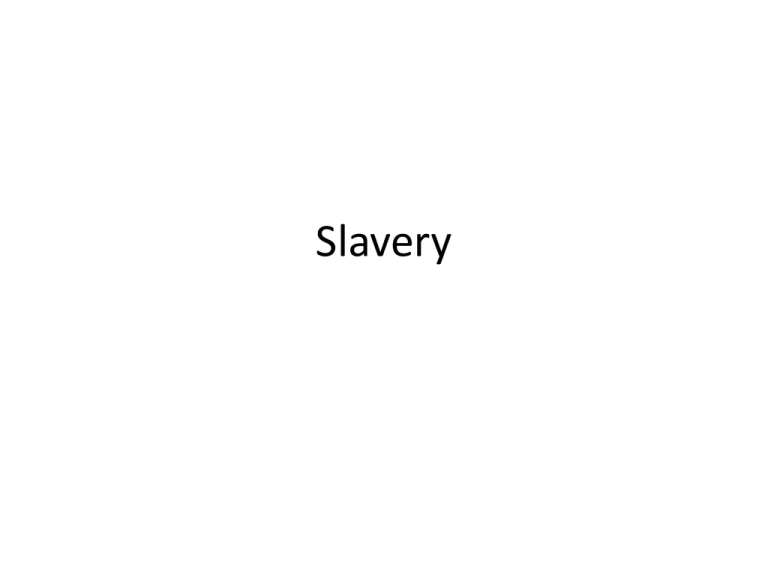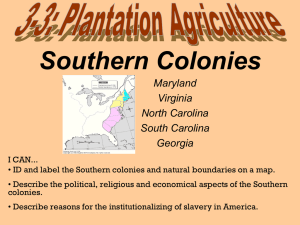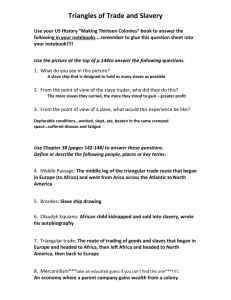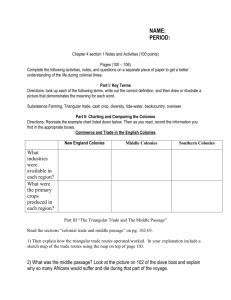Slavery - Kenston Local Schools
advertisement

Slavery Destination, Auction, and Seasoning • Most Africans landed in Brazil with the least number landing in North America. • Slaves were auctioned off to the highest bidder. • Slaves were put through a process of “seasoning” to get them ready for work. • They learned an European language, were named an European name, and were shown labor requirements. The Beginnings of Slavery in the United States • The Portuguese and Spanish had already brought Africans to South and Latin America. • In 1619, the first Africans were brought to the colony Jamestown. • Carolinas to work on plantations The Triangular Trade • New England merchants gain access to slave trade in the early 1700s 1. Rum brought to Africa, exchanges for slaves 2. Ships cross the Middle Passage, slaves trades in the West Indies. • Disease, torture, malnourishment, death for slaves 3. Sugar brought to New England • Other items trades across the Atlantic, with substantial profits from slavery making merchants rich Manufactured Goods •Furniture •Clothing •Colonials had not factories. From England to Colonies Initially, slavery was not the dominant system of labor for the colonies. It was Indentured Servitude. Headright System Indentured Contract Freedom Dues Why Not Enslave the Native Population? • Native Americans were highly likely to catch European diseases. • They were familiar with the terrain and could escape easier. • They had political allies that could fight against the “owners.” Reasons for Using Enslaved African Labor and Ending Indentured Servants • Proximity-It only took 2-6 weeks to get to the colonies from the Caribbean at first. • Experience-They had previous experience and knowledge working in sugar and rice production. • Immunity from diseases-Less likely to get sick due to prolonged contact over centuries. • Low escape possibilities-They did not know the land, had no allies, and were highly visible because of skin color. • Bacon’s Rebellion Anthony Johnson • He was an African brought to the colonies in the 1620s. • He obtained his freedom, and purchased 250 acres of land in Virginia. • He owned at least one slave and white indentured servants. • This shows that blacks were not thought of strictly as slaves until the 1660s. Slavery in the Colonies • New England colonies-no large plantation systems; slaves lived in cities and small farms • Chesapeake Bay colonies-large tobacco plantations; center of the domestic slave trade • Carolinas and Georgia-large rice and cotton plantations Slavery and the Colonies • Slavery in the North – Since the economics of New England and the Middle Colonies were based on small farms, slavery was far less important – Given that slaves were few and posed little threat to the white majority, laws were less harsh than in the South – Slaves did represent a sizable percentage of urban laborers, particularly in New York and Philadelphia Life of a Slave • Most slaves had Sundays off and they went to church. • Most slaves could not read or write, and it was illegal for them to learn. • Slave Codes-They could not: leave their home without a pass, carry a weapon, gather in groups, own property, legally marry, defend themselves against a white person, or speak in court. Resistance • Flight-Slaves would runaway. • Truancy-Flight for a short amount of time and then the slave came back. • Refusal to reproduce-Women refused to have children. • Covert Action-Slaves would sometimes kill animals, destroy crops, start fires, steal stuff, break tools, poison food. • STONO Rebellion-failed revolt in South Carolina in 1739 Punishment • Slaves were often brutally punished for misbehaving. • Punishments included: whipping, branding, being sold, gagged (silence), and other torturous methods were used.



